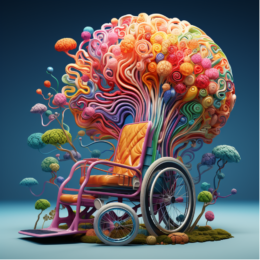Huntington’s Disease: Symptoms, Diagnosis & Management

Huntington’s disease (HD) is a complex genetic disorder that profoundly impacts patients and their families. It’s a question often asked: “Which is a symptom that is common in people with Huntington’s disease?” While many symptoms exist, one that stands out prominently is involuntary movements, known as chorea. But what exactly is Huntington’s disease, and which treatment has the best utility for Huntington’s disease? Let’s delve into this topic.
Overview of Huntington’s Disease
Genetic Basis of HD
It’s important to understand what type of genetic disorder is Huntington’s disease. It is an inherited disorder caused by a faulty gene on chromosome 4. This gene provides the blueprint for a protein called huntingtin. When this gene is defective, it produces an abnormal version of the huntingtin protein, which leads to the disease.
Facts and Statistics: The mutation causing Huntington’s disease involves a DNA segment known as a CAG trinucleotide repeat. This segment comprises a series of three DNA building blocks that repeat 36 to 120 times in people with Huntington’s, as opposed to 10 to 35 repeats in people without the disease. (Source: Genetics Home Reference)
How Common is Huntington’s Disease?
Huntington’s disease is relatively rare, with about 5 to 10 cases per 100,000 people in Western countries. The disease affects both males and females equally.
Facts and Statistics: Approximately 30,000 Americans have HD, but the disease affects populations all over the world. In European populations, the prevalence is about 5 to 7 per 100,000 people. (Source: Huntington’s Disease Society of America)
Age of Onset and Disease Progression
Typically, the disease manifests between the ages of 30 to 50, although juvenile onset Huntington’s can affect individuals as young as two years old. Symptoms usually progress over a 10 to 25-year period.
Facts and Statistics: Juvenile Huntington’s disease (onset of symptoms before age 20) accounts for approximately 5 to 10% of all HD cases. (Source: National Institute of Neurological Disorders and Stroke)
Common Symptoms of Huntington’s Disease
Huntington’s disease manifests in three primary domains: motor control, cognition, and psychology.
Motor Symptoms
Motor symptoms are often the first to appear and include involuntary movements (chorea), problems with coordination, difficulty swallowing, and speech difficulties
Facts and Statistics: Chorea affects approximately 90% of individuals with HD at some point in the course of their disease. (Source: National Institute of Neurological Disorders and Stroke)

Cognitive Symptoms
Cognitive symptoms include problems focusing on tasks, difficulty processing thoughts, and impaired memory. Patients may also find it difficult to learn new information.
Facts and Statistics: More than 90% of people with HD develop cognitive symptoms which interfere significantly with daily activities. (Source: National Institutes of Health)
Psychiatric Symptoms
Mood disorders such as depression, apathy, irritability, and anxiety are common in Huntington’s patients.
Facts and Statistics: Approximately 33-76% of HD patients experience depression and approximately 34-61% experience anxiety. (Source: National Institutes of Health)
Focus on a Specific Symptom: Involuntary Movements (Chorea)
Chorea, a hallmark symptom of Huntington’s disease, refers to involuntary, irregular, abrupt movements that appear to flow from one muscle to another. These movements are often among the first symptoms that lead people to seek medical attention and can significantly affect their quality of life.
While chorea can manifest differently in each individual, common characteristics include:
- Unpredictability: Movements can occur without warning at any time, and they may shift from one part of the body to another.
- Variability: The severity and frequency of chorea can vary widely from person to person and even from day to day in the same individual.
- Widespread Impact: While chorea can affect any part of the body, common areas include the hands, feet, and face. These movements can interfere with daily activities such as walking, talking, eating, and even maintaining posture.
- Progression: In the early stages of Huntington’s disease, some people might describe these movements as restlessness or clumsiness. As the disease progresses, these movements can become more pronounced and disruptive.
- Combination with other symptoms: Chorea is often accompanied by other motor symptoms of Huntington’s disease, such as dystonia (muscle stiffness) and bradykinesia (slowness of movement).
Chorea can pose significant challenges for those living with Huntington’s disease. It can interfere with a person’s ability to perform routine tasks, lead to injuries, and cause exhaustion. Social interactions can also become difficult, as others may not understand the nature of these involuntary movements.
Facts and Statistics: A survey by the Huntington’s Disease Society of America found that 40% of patients and caregivers identified chorea as the symptom most negatively impacting quality of life.
Diagnosis and Management
Diagnostic Criteria for Huntington’s Disease
A diagnosis of Huntington’s disease is typically based on genetic testing, neurological and psychological assessments, and family history.
Facts and Statistics: Genetic testing for Huntington’s has a 99% accuracy rate in confirming the presence of the mutation. (Source: Huntington’s Disease Society of America)
Importance of Early Diagnosis
Early diagnosis can lead to a better quality of life, allowing for earlier interventions and symptom management.
Facts and Statistics: Early diagnosis of HD can allow for interventions that may delay the onset of some symptoms by up to 3-5 years. (Source: Clinical Genetics)
Current Treatments for Chorea and Symptom Management
It’s important to understand that there is currently no cure for Huntington’s disease. However, medications can help manage symptoms. Tetrabenazine is commonly used to control chorea, while antipsychotics can manage psychiatric symptoms.
Facts and Statistics: Tetrabenazine, a medication used to control chorea, can reduce these involuntary movements by about 25% on average. (Source: Movement Disorders)
Research and Future Directions
Ongoing Research on HD and Its Symptoms
Research is ongoing to understand the pathogenesis of HD, focusing on the Huntingtin protein and its role in the disease process.
Facts and Statistics: The U.S. National Institutes of Health funded over $56 million in research into Huntington’s disease in 2020 alone.
Potential Therapies and Interventions Under Investigation
Many new therapies are being investigated, including gene therapy and stem cell therapy, aiming to slow or halt the progression of the disease.
Facts and Statistics: As of 2021, there are over 50 clinical trials related to Huntington’s disease registered on ClinicalTrials.gov, investigating novel treatments, including gene and stem cell therapy.
The Importance of Support for HD Patients and Families
For those affected by HD, psychosocial support can provide an invaluable lifeline. This includes support groups, counseling, and respite care for family members.
Facts and Statistics: A survey found that over 40% of HD patients and caregivers identified support groups as a critical resource for managing the disease. (Source: Journal of Huntington’s Disease)
Conclusion
In conclusion, understanding Huntington’s disease is vital for raising awareness and encouraging early diagnosis. By continuing to investigate the genetic basis of this disease and potential treatments, we can hope to improve the prognosis and quality of life for those living with this devastating disease.
References
- Genetics Home Reference. (2021). Huntington disease. U.S. National Library of Medicine. https://ghr.nlm.nih.gov/condition/huntington-disease
- Huntington’s Disease Society of America. (2022). What is HD? https://hdsa.org/what-is-hd/
- National Institute of Neurological Disorders and Stroke. (2021). Huntington’s Disease: Hope Through Research. https://www.ninds.nih.gov/Disorders/Patient-Caregiver-Education/Hope-Through-Research/Huntingtons-Disease-Hope-Through
- National Institutes of Health. (2021). Huntington’s Disease. U.S. National Library of Medicine. https://www.nlm.nih.gov/medlineplus/huntingtonsdisease.html
- Clinical Genetics. (2021). Early interventions in risk groups for Huntington disease: Ethical considerations. https://onlinelibrary.wiley.com/doi/full/10.1111/cge.12976
- Movement Disorders. (2016). Efficacy and Safety of Deutetrabenazine for the Treatment of Chorea Associated With Huntington Disease: Results from FirstHD. https://www.ncbi.nlm.nih.gov/pmc/articles/PMC4962762/
- ClinicalTrials.gov. (2022). Huntington’s Disease Clinical Trials. https://clinicaltrials.gov/ct2/results?cond=Huntington+Disease
- Journal of Huntington’s Disease. (2019). Exploring the Needs of Persons with Huntington’s Disease: A Qualitative Study. https://content.iospress.com/articles/journal-of-huntingtons-disease/jhd190354


